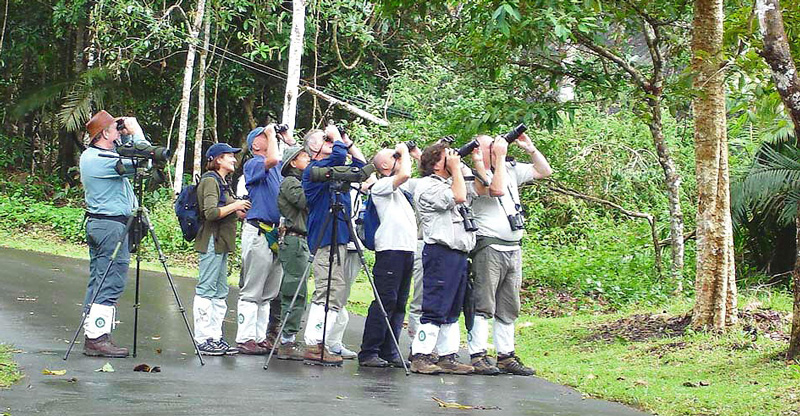Habitats
1. EVERGREEN FOREST
Tropical rain forest is dense, continuous canopy has a middle storey and a herbaceous forest floor etc. In Thailand it can be divided into two subtypes; the Thai type of rainforest, which formerly occupied most the lowland of Thailand and the Malayan rainforest type which is confined to the provinces of Yala, Narathiwat and southern Trang. Small areas of rainforest are also found in the wettest areas of South-east Thailand. Bird species diversity in this forest type is very high.
Thailand has a variation types of forest as follows :
Semi-evergreen and dry-evergreen forest are dense and stratified and usually has a deciduous component, these occur in the lowland and submontane slope below 900 m throughout the country. This forest type also supports a great diversity of bird species including pheasants, pigeons, cuckoos, owls, trogons, hornbills, kingfishers, barbets, woodpeckers and many passerine families.
Hill evergreen forest occur above 900 m or 1,000 m on the higher peaks thoughout the country especially the north, west, some in the Southeast and Peninsula. Dominant trees are oaks and chestnuts etc. This type of forest supports a great diversity of birds including minivets, bulbuls and is specially good for Rufous-throated Partridge, Hume’s Pheasant and Rufous-throated Hornbill etc.
2. DECIDUOUS FORESTS
DECIDUOUS FORESTS are found in the lowlands where the rainfall is too seasonal to support evergreen forest.
Dry dipterocarp forests occur in all the lowland but the largest and least disturbed areas are found in the North and West. This supports a lower range of bird species than other forest types as there is less middle storey and under-storey vegetations. Among the smaller birds, Black-winged Cuckoo-Shrike, Goden-fronted Leafbird, Rufescent Prinia, Brown Prinia, Great Slaty Woodpecker, White-bellied Woodpecker, Lineated Barbet, Eurasian Jay, Blue Magpie and Rufous Treepie etc. are found in this type of forest.
Mixed deciduous forests occur in the plains or valleys and on hill slope to 1,000 m, they are found in the North, Northeast and Southwest regions. Teak is dominant in this forest type. The bird species show less diversity than lowland evergreen forests but it is ideal habitat for Black-headed Woodpecker, Rufous Treepie, Golden-fronted Leafbird, Banded Broadbill and Blue Pitta etc.
3. OTHER FOREST TYPES
CONIFEROUS FORESTS occur on drier ridge and plateaus at elevation 400-1400 m in the North and Northeast regions. It supports a low diversity of bird species but is the habitat for Giant Nuthatch, Great Tit, Grey-headed Woodpecker, Greater Yellow-nape, Eurasian Jay and Grey Treepie etc.
FOREST ON LIMESTONE occur around the margins of the major mountain massifts. One species of forest birds, the Limestone Wren Babbler is confined to limestone habitats and is found in small areas of the North, Southwest and at the southwest margin of the Khorat Plateau in the Northest region. Other species relate to this area including Dusky Crag Martin, Red-rumped Swallow and Peregrine Falcon etc.
BAMBOO occurs as a mosaic with other forest habitats and a great many bird species utilise bamboo including White-browed Piculet, Rufous Warbler and Pin-tailed Parrotfinch etc.
MANGROVE FORESTS are found in the Gulf of Thailand and along both Peninsular coasts. it provides nesting and roosting areas for large colonial water-birds. Species such as Brown-winged Kingfisher, Mangrove Pitta, Ruddy Kingfisher, Flyeater, Mangrove Whistler and Copper-throated Sunbird are found in the mangrove.
FRESHWATER SWAMP FOREST Some small areas of secondary, scrub forest remain in Peninsular Thailand in Pa Phru of Narathiwat Province, in the far south. No species of birds are restricted to swamp forest but some species such as Cinnamon-headed Pegeion, Large Green Pigeon, Red-crowned Barbet, and Fluffy-backed Tit-Babbler utilise this type of forst.
